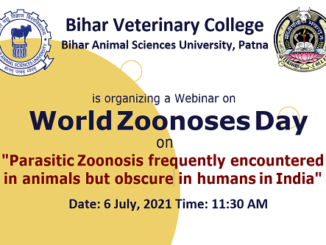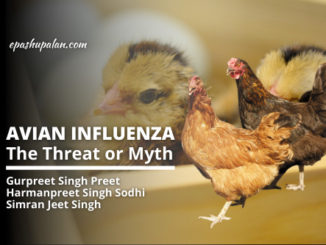Abstract
Recently, it was discovered that swine acute diarrhea syndrome may replicate in primary human cells, particularly human lung and intestinal cells, according to certain publications. These findings suggest that viruses from poultry and animals, which have a broad host range, should be given more attention. Infectious illnesses of cattle pose a serious danger to human life as well as the country’s economic development. In this post, we give a quick introduction of some of the challenges surrounding cattle infectious illnesses.
Keywords: emerging infectious diseases, viruses, zoonotic diseases, sustainable livestock farming
Introduction
At the turn of the century, the globe is confronted with a shifting panorama of infectious illnesses that impact both humans and animals, posing substantial dangers to human health and welfare as well as the worldwide food security agenda. In many regions of the globe, livestock illnesses that have severe effects on health of animals and have an influence on national and international trade are still prevalent. Climate change, hydrology, ecological disturbance, and changes in agriculture (intense methods of husbandry, monoculture agriculture, food processing, and so on), as well as the demographics and connectedness of the contemporary ‘global’ community continue to fuel the emergence of fears from old and new pathogens (Population expansion, urbanization, worldwide trade, global tourism, and quick transit are only some of the issues that need to be addressed; Gibbs 2005).
According to estimates, 60 percent of existing infections in humans are zoonotic (pathogen-caused diseases), and at least 75 percent of constructing contagious illness in humans (including Ebola, HIV, and influenza) have a zoonotic (pathogen-caused disease) source, with more than five new human diseases emerging each year.. Animals that have the most contact with humans include poultry and domestic animals (including pets). Their life habitat, particularly in large-scale farming, is strikingly similar to that of humans, providing ideal circumstances for viral development and diversity. As a result, these animals serve as intermediary hosts or mixers for viruses that infect humans. (PNAS)
Furthermore, there are six known swine corona viruses: PEDV stands for porcine epidemic diarrhoea virus, while TGV is for contagious gastroenteritis virus (TGEV), porcine delta corona virus (PDCoV), SADS-CoV, porcine respiratory corona virus (PRCV), and porcine hemagglutinating encephalomyelitis virus (PHEV). PEDV, TGEV, SADS-CoV, and PRCV belong to Alphacoronavirus, while PHEV and PDCoV belong to Betacoronavirus and Deltacoronavirus, respectively.
For some years, there has been an increase in the appearance or revival of animal and human infectious illnesses in various regions of the world (Weiss & McMichael 2004; Gibbs 2005; Woolhouse et al. 2005). Over 1600 human pathogens have been identified, with three new illnesses being reported every two years on average, and a new infecting organism being identified every week.
Other livestock disease is African swine fever (ASF), and the major cause of this kind of disease is pigs. It causes a very serious hemorrhagic fever in pigs. Up to this date there is no vaccine for this disease.
Several groups have demonstrated in recent decades that several viruses that cause human infection or epidemics originate in poultry and livestock, with corona viruses, rabies viruses, and influenza viruses being the most commonly reported viruses, all of which have caused significant harm to human health and public safety. Human cells were likewise discovered to be tolerant for the productive infection of swine circovirus. This virus has resulted in a number of human fatalities. Humans get infected with this virus, which is transmitted by bats.
A new influenza A (H1N1) virus emerged in the spring of 2009 and quickly spread over the world, prompting the World Health Organization to proclaim a pandemic on June 11th. According to epidemiological data, a spread in human beings occurred in mid-February in Veracruz, Mexico (Fraser et al. 2009), and the virus is linked to swine influenza.
The changing occurrence of infections and disease patterns throughout time necessitates the scientific community reviewing, developing, and employing a variety of abilities. Climate change, for example, and the expansion of vector-borne illnesses have created a demand for additional entomologists and vector biologists. Robinson and Dalton (2009).
The availability of effective and realistic therapies is required for control. A vaccination or other primary preventative, a curative therapy, or a method of vector elimination might all be examples of such treatments. Interventions should preferably be effective, safe, affordable, long-lasting, and simple to implement. In contrast to these technological feasibility difficulties, control must be financially viable and politically acceptable. (Nelson 1999; Miller et al. 2006; ITFDR 2008).
Infectious illnesses are notoriously difficult to eradicate, with only the smallpox virus having been declared eliminated. Regrettably, most illnesses have morphologies with several pathogenic forms that are either steady (antigenic variety) or change antigenic form over time (antigenic change), restricting eventual elimination success. The prevalence of numerous serogroups or variations of a disease makes long-term immunization control difficult, and it appears that more comprehensive successes, such as the elimination of smallpox and rinder pest virus, are more ambitious than attainable. However, progress is being made in the control of a number of major cattle diseases, and systems are now in place to bring together the necessary scientific competence and political determination to succeed.
The health and well-being of animals and people are both threatened by livestock and zoonotic illnesses. The utilization of cutting-edge technology for diagnosis and management in order to establish a global network of intelligence on the spread of these diseases. The utilization of cutting-edge technology for diagnosis and monitoring in order to establish a global network of intelligence on the spread of these diseases. For some critically vital conditions, an assessment of the threat posed will be the first line of defense. Stevens et al. (2009).
Conclusion
After these information mentioned above, we conclude that we should pay concern about the diseases spreading from livestock. We only see the productive side of livestock but now is the time to take our interest to this important and serious problem or else it would affect our lives too. Over the last few decades, there has been a significant change toward pro-poor livestock production, as well as a wide range of interesting developments. Over the next few decades, the goal will be to find new ways to maximize livestock’s participation to worldwide wellbeing, prosperity, equity, and conservation by developing new technologies, gathering evidence, and changing mindsets.We used to believe that diseases are uncontrolled and that there is no use in attempting to cure them. Today, it is legitimate to discuss disease management measures in conjunction with a properly supported veterinary system and organizations. It is only via correct functioning that we may be able to remove these disorders.
Reference
- Anke K. WiethoelterFaculty of Veterinary Science, The University of Sydney, New South Wales 2006, Australia;
- Daniel Beltrán-AlcrudoFood and Agriculture Organization of the United Nations (FAO), 00153 Rome, Italy;
- Richard KockDepartment of Pathology and Pathobiology, Royal Veterinary College, University of London, Hertfordshire AL9 7TA, United Kingdom;
- Siobhan M. MorMarie Bashir Institute for Infectious Diseases and Biosecurity, The University of Sydney, New South Wales 2006, Australia
- Liu et al Human cells are permissive for the productive infection of porcine circovirus type 2 in vitro. Sci. Rep. 9, 5638 (2019)
- Weiss R. A., McMichael A. J.2004Social and environmental risk factors in the emergence of infectious diseases. Nat. Med. 10, S70–S76 (doi:10.1038/nm1150)
- Gibbs E. P.2005Emerging zoonotic epidemics in the interconnected global community. Vet. Rec. 157, 673–679
- Forni, R. Cagliani, M. Clerici, M. Sironi Molecular evolution of human coronavirus genomes. Trends Microbiol. 25, 35–48 (2017).
- Fraser C., et al.2009Pandemic potential of a strain of influenza A (H1N1): early findings. Science324, 1557–1561. (doi:10.1126/science.1176062).
- Robinson M. W.& Dalton J. P.2009Zoonotic helminth infections with particular emphasis on fasciolosis and other trematodiases. Trans. R. Soc. B 364, 2763–2776.
- Nelson A. M.1999The cost of disease eradication. Smallpox and bovine tuberculosis. NY Acad. Sci. 894, 83–91.
- Stevens M. P., Humphrey T. J.& Maskell D. J.2009Molecular insights into farm animal and zoonotic Salmonella infections. Trans. R. Soc. B 364, 2709–2723.
- Special mention to Jeroen Dijkman, Thomas Randolph and Keith Sones for their drafts of the manuscript.






Be the first to comment